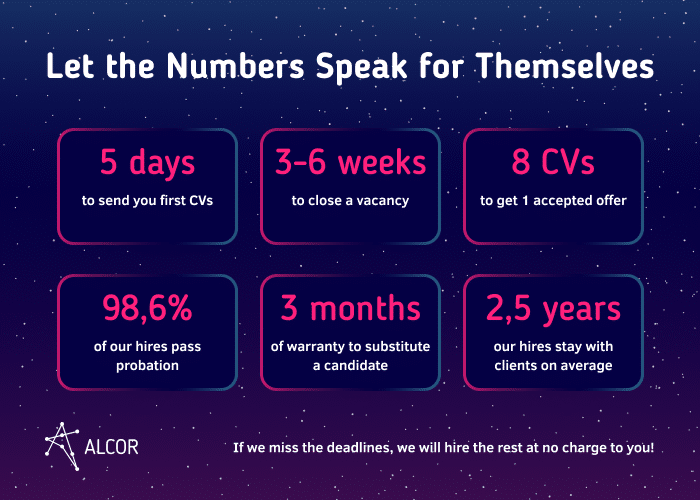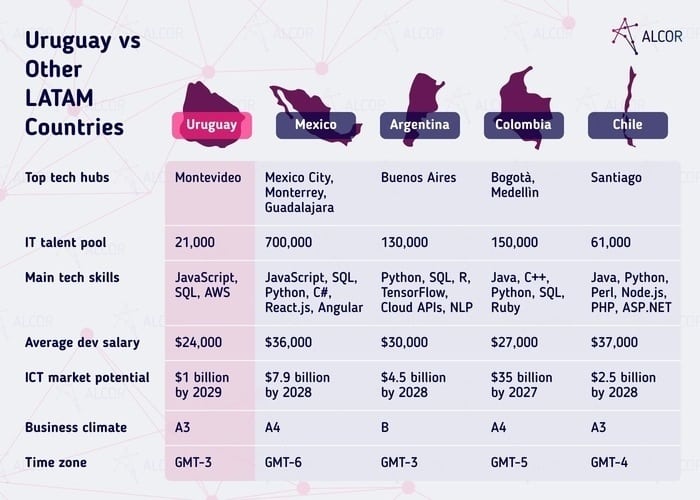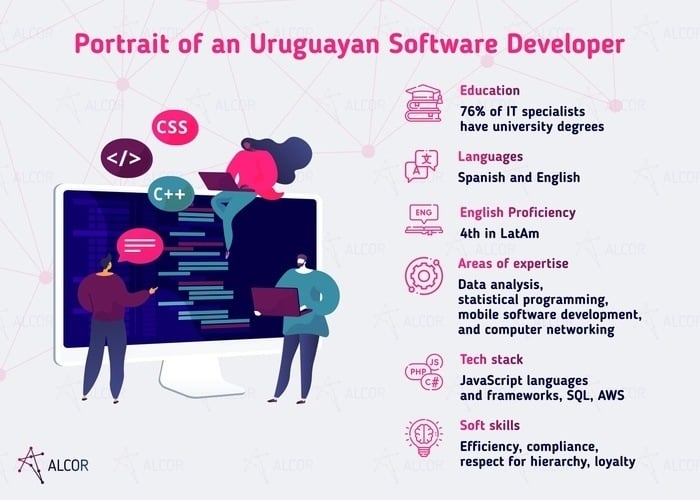Uruguayan IT exports, showing a notable 20% rise from 2021 to 2022, are driving foreign companies to nearshore to Uruguay. The trend continues thanks to vertical app development and IT services turnovers. Who wouldn’t want to partake in Uruguay’s rapid growth? Its technology potential singles it out as one of the most profitable destinations for outsourcing. So, what are Uruguay’s nearshoring advantages on the global tech scene?
I’m David Gomez, Alcor’s IT Recruitment Lead in LATAM, with 8 years of experience hiring seasoned software developers. At Alcor, we provide Tech Recruitment & EoR services as part of our all-in-one R&D center solution for tech companies seeking expeditious team scaling.

In today’s piece, I’ll shed light on the latest nearshore IT stats about Uruguay, including its business landscape, offshoring and nearshoring merits, software IT professional portrait, and pro tips for your outsourcing strategy to Uruguay. Diving in?
Nearshore Technology Landscape in Uruguay
Uruguay’s IT market has got what it takes to skyrocket:
- The Uruguayan ICT market makes up 3% of its GDP.
- The IT services market will peak at $1B in 2029, fueled by cloud computing, big data analytics, and cybersecurity.
- Uruguay demonstrates a top-tier track record of software development outsourcing to the US (74% of exports), the UK, and Chile, beating Argentina and Chile. These stats underscore the trend of IT nearshoring to Uruguay.
- Cybersecurity is the leading IT sector in Uruguay, placing it in the top-3 of the ITU America’s Global Cybersecurity Index and establishing it as one of the most advanced countries in the region.
- In the Latin American market, Uruguay comes 4th in the Global Innovation Index 2023 and has the highest GitHub usage per million, reflecting its prowess in technology.
To ensure further IT nearshoring growth, Uruguay has achieved 94% mobile data penetration nationwide and is expanding its focus to AI & IoT software development. Two initiatives highlight this push — “Open Digital Lab” for IoT testing and Microsoft AI & IoT Insider Lab, launched in 2023. Google also relentlessly supports software nearshoring to Uruguay. As confirmed in the recent IT nearshore news, the tech giant officially announced building a new data center in LatAm, 2nd of its kind.
Sprinkling in more IT data, the sector of technology in Uruguay comprises approximately 530 IT companies with about 24,000 employees in total. Plus, it boasts 1010 startups, including the unicorn (dLocal), startups merged with foreign firms (MonkeyLearn, KONA), and the presence of multinationals (Globant, Mercado Libre, Tata Consultancy Services). Fintech is Uruguay’s top-20 LatAm IT nearshore industry: Uruguayan stars include dLocal, Bankingly, MiFinanzas, Paganza, and Prometeo. But that’s not all: healthtech, AI, and cybersecurity startups are catching up.
How does Uruguay measure against other locations in LatAm, such as Argentina, Chile, Colombia, and Mexico? Check the picture below!

Reasons to Nearshore Software Development to Uruguay
Promising Tech Talent Pool
The standout reason for IT nearshoring in Uruguay is its impressive talent pool. It numbers at 21,000 developers. Despite looking small at first glance, it represents a 16% rise since 2021, according to the 2023 Microsoft report. In addition, Uruguay’s IT pool has the highest proportion of coders with skills in AI tech, surpassing even Chile and Brazil. The number looks set to grow thanks to a joint Amazon, INEFOP, and FORGE initiative, as well as such education programs as “Jóvenes a Programar,” “Sembrando TIC,” “Holberton” and “SoyHenry”, which collectively produce over 5,000 tech graduates annually.
The majority of IT-skilled professionals reside in Montevideo (85%), while the rest are spread out between Canelones (5%), Maldonado (3%), and other areas. Adding to the appeal, Uruguay’s ICT ecosystem and quality of life draw in tech gems from Argentina, Venezuela, Cuba, and India. Isn’t that exciting?
Moderate Developer Salaries
Overall, the salaries for outsourcing software development to Uruguay tend to be lower than the US wages. In the table below, we compared the remuneration for several positions, focusing on senior programmers with 5-7 years of experience.
| Senior Position | Gross Annual Income, USD | |
| Uruguay | USA | |
| Web Developer | $43,000 | $95,000 |
| AI Engineer | $60,000 | $132,000 |
| AWS Developer | $55,500 | $130,000 |
| DevOps Engineer | $62,500 | $138,000 |
| Python Developer | $57,500 | $126,000 |
| Java Developer | $57,500 | $114,000 |
| Data Science Engineer | $45,500 | $126,000 |
As you can see, the annual rates for development services in Uruguay range from $43K to $62,5K, while in the US, senior developers make about $95K-$138K, depending on the position. Therefore, when tech nearshoring to Uruguay, you can cut your IT team salary costs by up to 45%.
Favorable Business Climate
Taken in tandem with alluring Uruguayan salary rates, the country’s A3 business climate is a magnet to both domestic and foreign investors in the technology sector. IT investment is a national priority, leading to a wide array of incentives for software development. Did you know that you can operate under the free trade zone regime in Uruguay?
There’s more: under Law 19,637, you may be eligible for CIT exemption if your research and development activities relate to biotech, bioinformatics, and software production. The only condition is that the product is at least partly produced in Uruguay or, if it is a service, it should be provided within the country.
Time Zone Proximity
Another perk of nearshoring software development to Uruguay is its convenient time zone for collaboration with remote outsourced engineers. Located in the GMT-3 time zone, Uruguay is only one hour ahead of New York (GMT-4) and four hours ahead of California and San Fransisco (GMT-7). By opting for Uruguay, you will reap all the benefits: access top talent, slash costs, and meet your project deadlines with maximum efficiency and compatible delivery time.
Uncover the pros and cons of IT outsourcing to LATAM!
Innovation Advancement
Uruguayan IT innovation is relentless, spearheaded by AGESIC (Agency for Electronic Government and Information and Knowledge Society). Beyond its leadership in AI and digital services, Uruguay is part of Digital Nations, the top ten countries for tech development. The country also excels in e-government, securing third place in the UN E-Government Survey.
Regarding innovation-based entrepreneurship ecosystems, Montevideo shows excellent initiative and collaboration between IT business owners and stakeholders and sets the bar high for the rest of LatAm. Finally, government programs, such as “One Laptop per Child” and the rollout of the 5G network, further bolster the IT infrastructure and overall technological capacity of Uruguay.
Portrait and Proficiency of Uruguayan Software Developers
Coursera praises Uruguayan coders for their exceptional IT skills, especially in data analysis (90%), statistical programming and mobile software development (82%), and computer networking (80%). Other well-developed skills include JavaScript languages and frameworks, SQL, and AWS. In addition to the IT track record, Uruguay’s stellar English proficiency distinguishes it as the fourth tech nearshore hub in the region.
Tech education is highly valued in Uruguay: 76% of IT professionals hold university degrees, with over 60% having a Bachelor’s. Statistically, these are awarded by the top three country IT universities: 30% by Universidad de la República, 26% by Universidad ORT Uruguay, and 6% by Universidad Católica del Uruguay (UCUDAL), respectively.

Uruguay’s international technology cooperation and English and Spanish proficiency enhance its cultural affinity with the US and drive nearshore outsourcing. However, while being hard-working and compliant, Uruguayan IT professionals don’t show the tendency to disagree publicly. Their relationship-oriented culture and hierarchical values mean it’s uncommon for them to challenge company management. Additionally, deadlines may be viewed as flexible, so if you nearshore software development to Uruguay, set specific communication rules and adhere to Agile methodologies. Regarding retention, Uruguayan nearshore programmers typically stay with an employer for an average of 1.6 years, particularly at the middle, senior, and lead levels.
Tips on Software Development Nearshoring to Uruguay
What’s next after you set your sights on nearshore outsourcing to Uruguay? I recommend focusing on a viable model and an established provider of nearshore technology to Latin America.
Among various models for nearshoring software development services, like traditional outsourcing, team extension, staff augmentation, and others, my professional choice is to narrow down to IT recruitment, Employer of Record services, and R&D center. These models give you in-house nearshore coders with high loyalty levels, focused solely on your product, and without buy-out fees or risks, associated with outsourcing. Here’s a brief outline of them:
- EoR (Employer of Record) refers to hiring already available nearshore candidates on behalf of the nearshore provider’s company. This includes HR management, payroll, tax & accounting, and legal. It is ideal for testing the unfamiliar market but requires an in-house recruitment team.
- IT Recruitment encompasses full-cycle hiring of software developers to build a nearshore development team from scratch. It starts with crafting an Ideal Candidate Profile (ICP), refining your Employer Value Proposition (EVP) and continues with blind CVs, selection, hiring & employment with HR support. Cons? I see none unless scalability is not your goal.
- R&D center stands for your ultimate tech branch abroad. On top of the standard IT recruitment package, you’ll also get payroll & legal support, plus assistance in leasing an office and procuring equipment. If you’re looking for a comprehensive solution for pain-free scaling, that’s your go-to model.
To conclude, all three models work like a charm for beefing up a long-term product development process.
The next step to successful nearshore software development is choosing your provider. It’s a walk in the park if you factor in their experience in the tech market, client testimonials, guarantees, and a thorough approach to communication. Don’t overlook the latter; sometimes, it’s key to your success.
Let me tell you the story of our client Ledger, a French cryptocurrency IT company. They contacted Alcor with a request to hire 20 QA engineers for their software development hub abroad. This wasn’t just about finding talent; it also required navigating tax management, labor law assistance, IP rights protection, employment contract support, and other functions typically falling into the realm of EoR.
Our seasoned IT recruitment and legal teams stepped up, showcasing their expertise to fulfill Ledger’s requirements. But what truly set us apart was our communication. We kept in close contact remotely and invited Ledger’s management to fly in from Paris for a marathon day of live interviews. By the end of that day, they had hired a QA Manager on the spot!
In just two weeks, we brought on a QA Lead and three QA specialists, hitting all our IT recruitment targets with full transparency on legal compliance. Our swift, efficient process left Ledger truly wowed.
Nice to Meet You! We are Alcor — a Trusted R&D Center Provider
Alcor is your reliable technology nearshoring partner in the LATAM & EE tech talent oceans. Far better than traditional outsourcing: our 360-degree Tech Recruitment & EoR solution fully equips you to nearshore technology to Uruguay. We provide you with software development tech gems and handle HR, payroll, and legal, you welcome new in-house devs.
On top of that, we’re experts in opening R&D centers abroad, and we hassle-free cover everything from office lease to equipment procurement. Sift, Dotmatics, People,ai, and others have collaborated with Alcor and keep thriving!

At Alcor, we aim to ensure tech scalability and reduce the hiring time of IT professionals, and we’re succeeding! Our average time to hire software developers is 2-6 weeks, with 80% CV pass and 98,6% excellent probation period rates. Sounds ambitious? Check us out!
References on Nearshoring to Uruguay
- ICT Sector in Uruguay 2023 Report
- Statista (Software – Uruguay)
- International Trade Administration (ICT Uruguay)
- ITU America’s Global Cybersecurity Index 2020
- Global Innovation Index 2023
- Uruguay XXI news
- Traxcn: Overview of startups in Uruguay
- Microsoft & CUTI 2023. Uruguay: Talent Report on the IT Sector
- PwC: Uruguay Tax Summaries
- MIT D-Lab: Resumen Ejecutivo de Ciudad de Montevideo
- Coursera Global Skills Report 2024
- EF English Proficiency Index
- Observatorio TI: Monitor Laboral TI de Uruguay 2021
- EF English Proficiency Index 2024
- Commisceo
